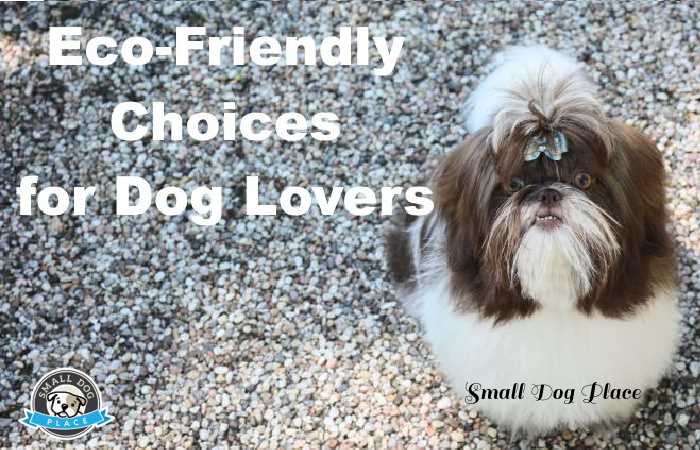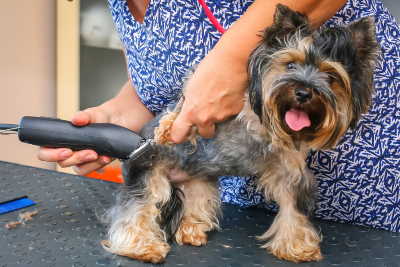- Small Dog Place Home
- Lifestyle
- Eco-Friendly Choices for Dog Lovers
Eco-Friendly Choices for Dog Lovers: Tips to Live Sustainably
Eco-Friendly Choices for Dog Lovers by Janice Jones
Published 03-02-2021
Are you one of those people who have a deep concern for the environment and how your impact affects the world at large? Are you also a dog lover?
Perhaps you have worried needlessly about how being a pet owner might affect your hope for living sustainably. I know that I struggle with these thoughts almost daily, especially when Earth Day approaches (April 22).
Sometimes it feels that there is no way to care for a dog while still striving to live an environmentally friendly lifestyle.
 Eco-Friendly Choices for Dog Lovers
Eco-Friendly Choices for Dog LoversThe good news is you can feel good about being a pet parent and still strive to live a lifestyle that benefits your environment.
To live climate-smart, one must begin to examine each aspect of one’s life, including our work life, home and family life, even the way we decorate our homes.
Eco-Friendly Choices for Dog Lovers: Tips
In this article, I’d like to look at the many ways we can care for our small dogs in the most environmentally friendly way. Perhaps you are already doing many of these things, and good for you if you are.
If not, hopefully, you’ll get some inspiration to create the very best care for your dog and still enjoy that climate-smart lifestyle you crave.
What Pet Products Are You Using?
Are they environmentally friendly? Let’s face it, as dog owners, we use a lot of cleaning products. If you don’t, then you are the lucky exception.
Green products such as floor or carpet cleaners can help save the environment and keep your home clean and smelling great. Even simple home-made solutions are better than harsh chemicals that are not healthy for dogs or you, let alone the earth where we live.
Consider two fundamental ingredients that are already in your pantry, baking soda and vinegar. Vinegar and water are perfect for clean-up.
If you want a nontoxic abrasive for cleaning bathrooms and kitchens, consider adding baking soda to your vinegar. It makes an excellent paste for scrubbing.
Before purchasing dog shampoos and conditioners, look at the label to see if the ingredients are natural. Suppose you prefer to go the DIY route. In that case, The American Kennel Club (AKC) provides a three-ingredient dog shampoo that is also good for the environment.
- 2 cups warm water
- ¼ cup nontoxic dish soap
- ½ cup white vinegar
Mix well and apply to your dog’s wet hair. Work in thoroughly, and then rinse well. Dry.
Dog Toys
Many dog toys are made out of plastic, and we all know that plastics are not suitable for the environment. Dogs don’t need plastic toys.
Just take a look at what an average dog might find irresistible: An old rag makes a great chew toy, especially if it has been knotted several times. Beyond chewing, dogs love to shake, chase and play tug of war with an old rag and if it has your scent on it, so much the better.
Recycled trash is another excellent choice for a dog toy. A used water bottle stuffed inside an old sock is an especially cherished dog toy.
Not only does the old sock and water bottle remain in your home and not the landfill, but it also has a pleasing crackle sound that dogs love.
Consider a DIY Kong-type toy by cutting open a flat tennis ball, leaving a small hole to stuff treats or even dog food bits. This is very popular in my home for several reasons.
It’s a ball, first and foremost. It smells like delicious food, and even when the treats are gone, my dogs are still trying to chew on the ball.
Dog Poop
Oh, the ubiquitous dog poop. The average dog produces 274 pounds of poop in a year. You might be able to use some of that for your flower gardens, but do not use it as fertilizer for any plants you plan to eat. What do you do with the rest?
Many people will toss it into a plastic bag and into the garbage, ending up in a landfill. A better alternative is to purchase bio-degradable poop bags that will degrade over time. The worst thing that a dog owner can do is not pick up after their dog. Poop left in parks, sidewalks, and other outdoor areas will eventually make its way along with the accompanying bacteria, viruses, and parasites into the urban watershed.
Recycle, Reuse
I mentioned this earlier when discussing dog toys, but what about all the other products we purchase for our dogs. Before tossing anything into the garbage, consider, can I repurpose this for my dog? Even old pieces of furniture, end tables, coffee tables, drawers from a dresser can be turned into a dog bed.
Make a soft dog bed out of an old pullover sweater. Stuff the arms with batting or other old rags and place a pillow inside the pullover.
Use a yarn needle and yarn to sew the neckline, bottom hem, and cuffs of the sleeves closed. Tack both sleeves together and attach them to the hemline or collar, depending on how well they fit.
Your dog will have a comfortable bed with a booster that smells like you, and you will have kept an old pillow and sweater far from the landfill.
You don’t need fancy dog water bowls and food dishes. A couple of mismatched pieces work just as well, and your dog won’t mind in the least.
Anything you can’t reuse may be recycled. Even empty bags of dog food can be recycled in some locations and open cans of food. Check with your local government to see what can and can’t be recycled.
Dog Potty Pads
Just like human diapers, these paper potty pads can add up quickly if you use them instead of taking your dog outside. Consider using an adult incontinent pad instead of the commercially available potty pads.
Yes, you will need to wash them, but you won’t be adding those extra pounds of garbage to an already overflowing landfill.
Air Fresheners
I don’t know about you, but I don’t want my home to smell like a dog, so I seek scents that mask the smell.
One thing I did learn long ago was the power of live plants in the home. Since plants take in carbon dioxide and give off oxygen, they are suitable for our indoor environment.
Essential oils placed in a diffuser can do double duty by giving off pleasant scents and calming your dog if you use ones such as lavender or chamomile.
Last Words
Being a pet owner and a person conscious of the threats, we pose to our environment are not mutually exclusive. We can do both—be a great pet parent and make environmentally friendly decisions. In most cases, the decisions we make are also cost-efficient. We save money by helping save the environment—a win-win, in my opinion.
Eco-Friendly Choices for Dog Lovers
Pin for Future Reference
Did You Find Eco-Friendly Choices for Dog Lovers Helpful?
About Janice (author and voice behind this site)
Having lived with dogs and cats most of her life, Janice served as a veterinary technician for ten years in Maryland and twelve years as a Shih Tzu dog breeder in Ohio.
Her education includes undergraduate degrees in Psychology with a minor in biology, Early Childhood Education, and Nursing, and a master's in Mental Health Counseling.
She is a lifelong learner, a dog lover, and passionate about the welfare of animals. Her favorite breed for over 50 years has been the Shih Tzu, but she has also lived with Poodles, Maltese, Yorkshire Terriers, Beagles, English Bulldogs, Carin Terriers, and a Cocker Spaniel.
When not writing, reading, and researching dog-related topics, she likes to spend time with her eight Shih Tzu dogs, husband, and family, as well as knitting and crocheting. She is also the voice behind Miracle Shih Tzu and Smart-Knit-Crocheting
Does This Article Deserve Your Thumbs Up?
We always appreciate your support and encouragement. Your thumbs up means so much to us. Please like this article.
If you find this page or any page on Small Dog Place Helpful, or useful in anyway, I'd love it if you would click the small heart found on the bottom right of each page.
You can also share or bookmark this page -- just click on the:

Free Monthly Newsletter
Sign Up for Our Free Newsletter and get our Free Gift to You.
my E-book, The Top 10 Mistakes People Make When Choosing a Dog (and how to avoid them)








